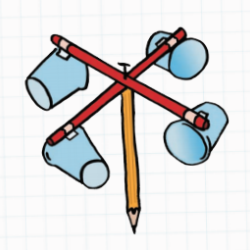Source Institutions
Source Institutions
Add to list Go to activity
Activity link broken? See if it's at the internet archive

In this engineering activity, learners build a device (an anemometer) to measure how fast the wind is blowing. Learners are encouraged to brainstorm, build, redesign/rebuild, collect data and continue exploring.
- Under 5 minutes
- 45 to 60 minutes
- $1 - $5 per group of students
- Ages 8 - 14
- Activity, Lesson/Lesson Plan
- English
Quick Guide
Materials List (per group of students)
- 1 unsharpened pencil (with eraser)
- 6 straws
- 10 T-pins
- 4 small paper or plastic cups
- 4 large paper or plastic cups
- 2 ft. of masking or transparent tape
- 1 fan
- stop watches or clock with second hand
- paper and pencils
Subjects
-
Earth and Space Science
-
Earth Processes
- Weather and Climate
-
Earth Processes
-
Engineering and Technology
-
Engineering
- Environmental Engineering
- Mechanical Engineering
- Technology
-
Engineering
-
Physical Sciences
-
Energy
- Work and Machines
-
Motion and Forces
- Momentum and Velocity
- Rotation Motion
-
States of Matter
- Solids
- Gases
-
Energy
-
Mathematics
-
Data Analysis and Probability
- Data Collection
-
Data Analysis and Probability
-
The Nature of Science
-
The Scientific Process
- Conducting Investigations
- Gathering Data
-
The Scientific Process
-
The Nature of Technology
-
Technology and Society
- Impacts of Technology
- Technology and the Environment
-
The Design Process
- Invention and Innovation
- Problem Solving
- Troubleshooting and Maintenance
-
Technology and Society
Informal Categories
- Nature and Environment
Audience
To use this activity, learners need to:
- see
- touch
Learning styles supported:
- Involves teamwork and communication skills
- Involves hands-on or lab activities
Culture, ethnicity, and gender
-
Girls
- Explicity developed for this group
- Acknowledges this group's contributions to STEM
- Highlights STEM opportunities for this group
- Identifies role models or mentors in STEM fields from this group
- Uses inclusive images of people from this group
Other
Components that are part of this resource:
Includes alignment to state and/or national standards:
This resource is part of:
Access Rights:
- Free access
By:
Rights:
- All rights reserved, Twin Cities Public Television, Inc., 2010
Funding Sources:
- National Science Foundation, 0813519
- ExxonMobil
